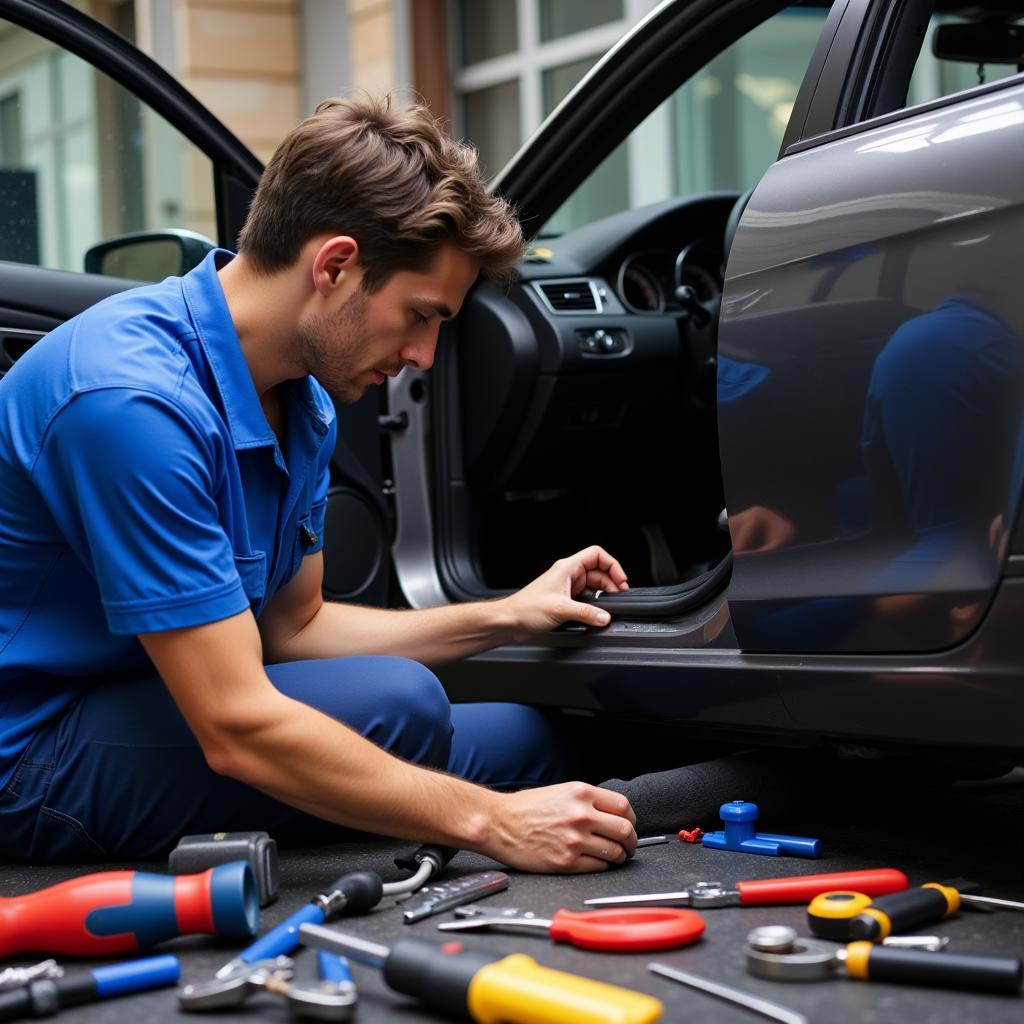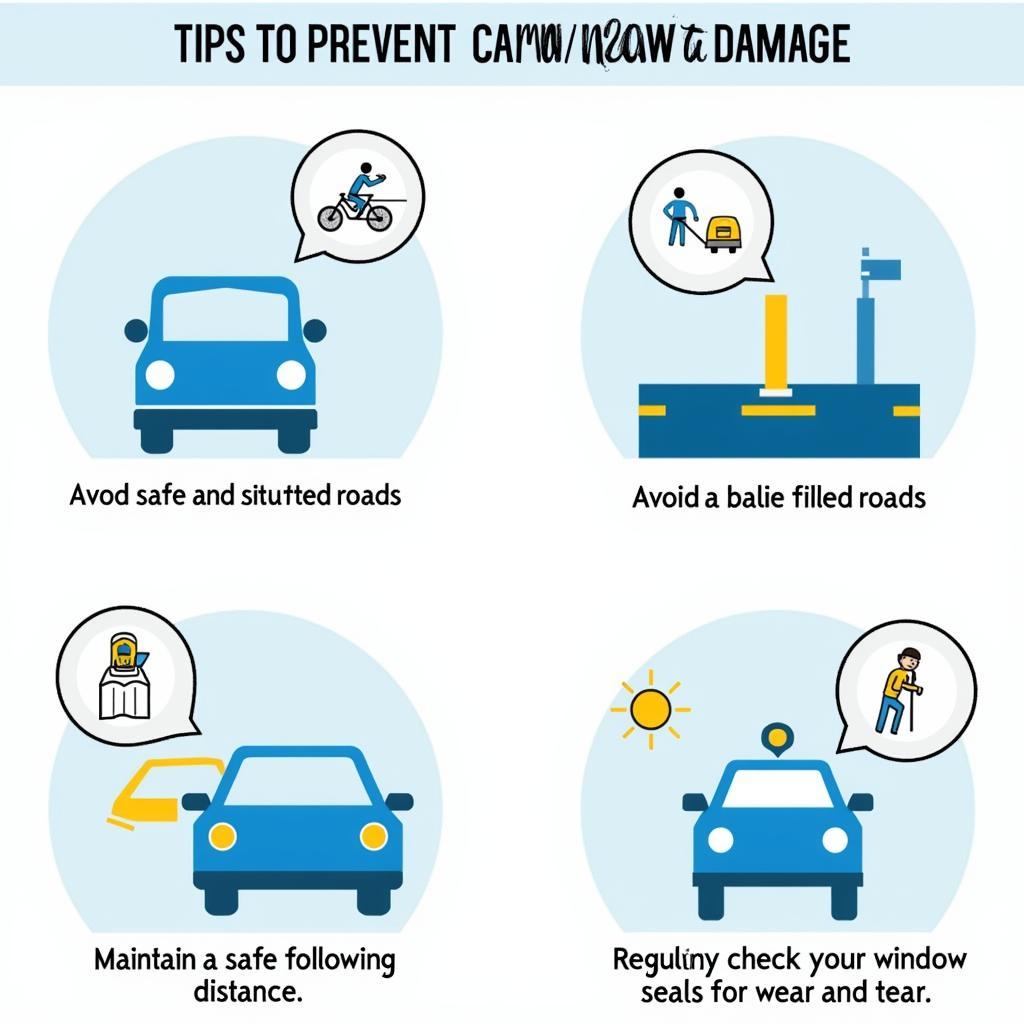Fixing a cracked or chipped car window can be a daunting task, especially if you’re considering tackling it yourself. While some cases definitely require professional help, many car window repairs can be done at home with the right tools, materials, and a bit of patience. This guide will walk you through everything you need to know about Car Window Repair At Home, from assessing the damage to achieving a long-lasting fix.
Assessing the Damage: DIY or Professional?
Before diving into a DIY car window repair, it’s crucial to determine if it’s the right approach for your situation. Minor chips and cracks, often resembling a bullseye or starburst, are usually repairable at home. However, larger cracks, those exceeding 6 inches, or those compromising the structural integrity of the window, require professional attention.
Here’s a quick breakdown:
DIY-Friendly:
- Small chips and cracks (less than 3 inches)
- Bullseye or starburst patterns
- Cracks not extending to the edge of the window
Professional Help Needed:
- Cracks larger than 6 inches
- Cracks extending to the edge of the window
- Multiple cracks or extensive damage
- Damage to the window frame
- Damage affecting the driver’s visibility
If you’re unsure, it’s always best to err on the side of caution and consult a professional auto glass technician. They can accurately assess the damage and recommend the most appropriate course of action.
Understanding Car Window Construction
Car windows are not simply single panes of glass. Most modern vehicles feature laminated glass, composed of two layers of glass sandwiching a layer of polyvinyl butyral (PVB). This construction provides strength and safety, preventing the glass from shattering into dangerous shards upon impact.
Understanding this structure is essential for successful car window repair at home. The goal is to fill the damaged area with a resin that bonds with the PVB layer, restoring the window’s structural integrity and preventing the damage from spreading.
Essential Tools and Materials
Before you begin, gather the following tools and materials for a successful DIY car window repair:
- Car window repair kit: These readily available kits contain everything you need, including resin, applicator, curing strips, and instructions.
- Clean microfiber cloths: For cleaning the damaged area and removing excess resin.
- Isopropyl alcohol: To ensure a clean and grease-free surface for optimal resin adhesion.
- Razor blade or plastic scraper: To remove any loose glass fragments or debris.
- Safety glasses and gloves: Protect your eyes and hands during the repair process.
Step-by-Step Guide to Car Window Repair at Home
Follow these steps to effectively repair a chipped or cracked car window:
-
Clean the Damaged Area: Using a clean microfiber cloth and isopropyl alcohol, thoroughly clean the damaged area and the surrounding glass. Remove any dirt, debris, or loose glass fragments. Ensure the surface is completely dry before proceeding.
-
Prepare the Repair Kit: Following the manufacturer’s instructions, prepare the resin and applicator as directed. Most kits involve attaching the applicator to the resin bottle or syringe.
-
Apply the Resin: Carefully position the applicator over the damaged area and slowly dispense the resin, ensuring it fills the entire chip or crack. Avoid trapping air bubbles.
-
Apply Curing Strips: Place a curing strip over the repaired area, pressing gently to remove any air pockets and ensure good contact between the resin and the strip.
-
Cure the Resin: Allow the resin to cure as per the instructions provided in the repair kit. Curing time varies depending on the product but usually takes between 15 minutes to an hour. Sunlight can accelerate the curing process.
-
Remove Curing Strips and Excess Resin: Once cured, carefully peel off the curing strips. Use a razor blade or plastic scraper held at a low angle to gently remove any excess resin, ensuring a smooth and flush finish.
-
Inspect the Repair: Thoroughly inspect the repaired area for any imperfections or remaining resin. Repeat steps 3-6 if necessary to achieve a satisfactory repair.
Common Car Window Repair Questions
Q: Can I drive my car with a cracked windshield?
A: While driving with a minor chip might be possible, it’s not recommended. Cracks can weaken the windshield’s structural integrity and compromise safety.
Q: How long does a DIY car window repair last?
A: A properly executed DIY repair can last for several years. However, factors like weather conditions and the severity of the initial damage can affect its longevity.
Q: Can I repair a car window in the rain?
A: No, it’s essential to perform the repair in a dry environment. Moisture can interfere with the resin’s curing process and compromise the repair’s effectiveness.
Q: How much does it cost to repair a car window professionally?
A: Professional repair costs vary depending on the damage’s extent and the car model. Expect to pay between $50 to $200 for chip repairs and significantly more for windshield replacements.
Conclusion
Car window repair at home can be a cost-effective and convenient solution for minor chips and cracks. By following the steps outlined in this guide and using the right tools and materials, you can achieve a long-lasting repair that restores your window’s structural integrity and improves its appearance. Remember to assess the damage carefully before starting, and don’t hesitate to seek professional help if needed.
For more information on car repair and maintenance, check out our articles on sweet home or car window repair and car window repair homestead.
Need immediate assistance with your car window repair? Contact our team of experts 24/7 via WhatsApp at +1(641)206-8880 or email us at [email protected].


